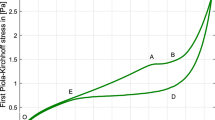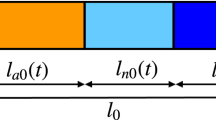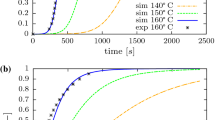Abstract
In this paper, we derive a model to describe the cyclic stress softening of a carbon-filled rubber vulcanizate through multiple stress–strain cycles with increasing values of the maximum strain, specializing to equibiaxial loading. Since the carbon-filled rubber vulcanizate is initially isotropic, we can show that following initial equibiaxial loading the material becomes transversely isotropic with preferred direction orthogonal to the plane defined by the equibiaxial loading. This is an example of strain-induced anisotropy. Accordingly, we derive nonlinear transversely isotropic models for the elastic response, stress relaxation, residual strain and creep of residual strain in order to model accurately the inelastic features associated with cyclic stress softening. These ideas are then combined with a transversely isotropic version of the Arruda–Boyce eight-chain model to develop a constitutive relation for the cyclic stress softening of a carbon-filled rubber vulcanizate. The model developed includes the effects of hysteresis, stress relaxation, residual strain and creep of residual strain. The model is found to compare extremely well with experimental data.
Similar content being viewed by others
References
Arruda E.M., Boyce M.C.: A three-dimensional constitutive model for the large stretch behavior of rubber elastic materials. J. Mech. Phys. Solids 41, 389–412 (1993). doi:10.1016/0022-5096(93)90013-6
Bergström J.S., Boyce M.C.: Constitutive modelling of the large strain time-dependent behavior of elastomers. J. Mech. Phys. Solids 46, 931–954 (1998). doi:10.1016/S0022-5096(97)00075-6
Bernstein B., Kearsley E.A., Zapas L.J.: A Study of Stress Relaxation with Finite Strain. Trans. Soc. Rheol. VII 71, 391–410 (1963). doi:10.1122/1.548963
Chagnon G., Verron E., Gornet L., Marckmann G., Charrier P.: On the relevance of continuum damage mechanics as applied to the Mullins effect in elastomers. J. Mech. Phys. Solids 52, 1627–1650 (2004)
Cohen A.: A Padé approximation to the inverse Langevin function. Rheol. Acta 30, 270–273 (1991). doi:10.1007/BF00366640
Diani J., Fayolle B., Gilormini P.: A review on the Mullins effect. Eur. Polym. J. 45, 601–612 (2009). doi:10.1016/j.eurpolymj.2008.11.017
Dorfmann A., Ogden R.W.: A pseudo-elastic model for loading, partial unloading and reloading of particle-reinforced rubber. Int. J. Solids Struct. 40, 2699–2714 (2003). doi:10.1016/S0020-7683(03)00089-1
Dorfmann A., Ogden R.W.: A constitutive model for the Mullins effect with permanent set in particle-reinforced rubber. Int. J. Solids Struct. 41, 1855–1878 (2004). doi:10.1016/j.ijsolstr.2003.11.014
Dorfmann A., Pancheri F.Q.: A constitutive model for the Mullins effect with changes in material symmetry. Int. J. Non-Linear Mech. 47, 874–887 (2012). doi:10.1016/j.ijnonlinmec.2012.05.004
Gent A.N.: A new constitutive relation for rubber. Rubber Chem. Technol. 69, 59–61 (1996). doi:10.5254/1.3538357
Horgan C.O., Saccomandi G.: A Molecular-statistical basis for the gent constitutive model of rubber elasticity. J. Elast. 68, 167–176 (2002). doi:10.1023/A:1026029111723
Horgan C.O., Ogden R.W., Saccomandi G.: A theory of stress softening of elastomers based on finite chain extensibility. Proc. R. Soc. Lond. A 460, 1737–1754 (2004). doi:10.1098/rspa.2003.1248
Kuhl E., Garikipati K., Arruda E.M., Grosh K.: Remodeling of biological tissue: Mechanically induced reorientation of a transversely isotropic chain network. J. Mech. Phys. Solids 53, 1552–1573 (2005)
Lally C., Reid A.J., Prendergast P.J.: Elastic behavior of porcine coronary artery tissue under uniaxial and equibiaxial tension. Ann. Biomed. Eng. 32, 1355–1364 (2004)
Lockett F.J.: Nonlinear Viscoelastic Solids. Academic Press, London (1972)
Machado G., Chagnon G., Favier D.: Analysis of the isotropic models of the Mullins effect based on filled silicone rubber experimental results. Mech. Mater. 42, 841–851 (2010). doi:10.1016/j.mechmat.2010.07.001
Machado G., Chagnon G., Favier D.: Induced anisotropy by the Mullins effect in filled silicone rubber. Mech. Mater. 50, 70–809 (2012). doi:10.1016/j.mechmat.2012.03.006
Merckel Y., Diani J., Brieu M., Caillard J.: Constitutive modeling of the anisotropic behavior of Mullins softened filled rubbers. Mech. Mater. 57, 30–41 (2013). doi:10.1016/j.mechmat.2012.10.010
Mullins L.: Effect of stretching on the properties of rubber. J. Rubber Res. 16(12), 275–289 (1947). doi:org/10.5254/1.3546914
Mullins L.: Softening of rubber by deformation. Rubber Chem. Technol. 42(1), 339–362 (1969). doi:10.5254/1.3539210
Németh, I., Schleinzer, G., Ogden, R.W., Holzapfel, G.A.: On the modelling of amplitude and frequency-dependent properties in rubberlike solids. In: Austrell, P.E., Kari, L. (eds.) Constitutive Models for Rubber IV, pp. 285–298 (2005)
Rickaby S.R., Scott N.H.: Transversely isotropic cyclic stress-softening model for the Mullins effect. Proc. R. Soc. Lond. A. 468, 4041–4057 (2012). doi:10.1098/rspa.2012.0461
Rickaby S.R., Scott N.H.: A cyclic stress softening model for the Mullins effect. Int. J. Solids Struct. 50, 111–120 (2013). doi:10.1016/j.ijsolstr.2012.09.006
Rickaby, S.R., Scott, N.H.: Multicyclic modelling of softening in biological tissue. IMA J. Appl. Math. 1–19 (2013b). doi:10.1093/imamat/hxt008
Author information
Authors and Affiliations
Corresponding author
Rights and permissions
About this article
Cite this article
Rickaby, S.R., Scott, N.H. A model for the Mullins effect during multicyclic equibiaxial loading. Acta Mech 224, 1887–1900 (2013). https://doi.org/10.1007/s00707-013-0854-x
Received:
Revised:
Published:
Issue Date:
DOI: https://doi.org/10.1007/s00707-013-0854-x




